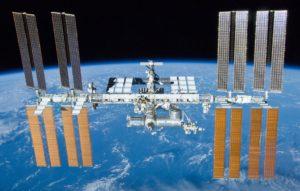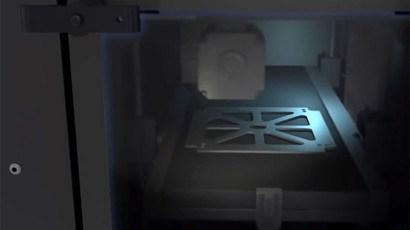Russian Space Agency Roscosmos Developing Experiment to 3D Print Living Tissue on the International Space Station
 Space, the final frontier…and another venue, with a great view, for 3D printing! It’s been over two years since the first functioning 3D printed object was fabricated in space, and since then, the 3D printing innovation train has been barreling down the tracks. We’ve written about projects completed on and for the International Space Station (ISS) before, including 3D printing spare parts in space, and the ongoing Space Design Contest from Made In Space and Pinshape. But while we’ve seen work done for bioprinting in zero-G we don’t hear too much about medical 3D printing in space yet. That is about to change, as news sources are reporting that an experiment to 3D print living tissue on the ISS is in the early development phases at Russian space agency Roscosmos, also known as the Roscosmos State Corporation for Space Activities.
Space, the final frontier…and another venue, with a great view, for 3D printing! It’s been over two years since the first functioning 3D printed object was fabricated in space, and since then, the 3D printing innovation train has been barreling down the tracks. We’ve written about projects completed on and for the International Space Station (ISS) before, including 3D printing spare parts in space, and the ongoing Space Design Contest from Made In Space and Pinshape. But while we’ve seen work done for bioprinting in zero-G we don’t hear too much about medical 3D printing in space yet. That is about to change, as news sources are reporting that an experiment to 3D print living tissue on the ISS is in the early development phases at Russian space agency Roscosmos, also known as the Roscosmos State Corporation for Space Activities.
Using a 3D printer to produce living tissue is a pretty cutting edge biomedical technology, one we hear about most often from companies like Organovo and institutes such as Wake Forest and Harvard; it can also be a legally challenging minefield to navigate, as laws of nature are generally patent ineligible. 3D printing living tissue is extremely difficult: once you’ve successfully created and 3D printed the cellular structures, you still have to keep the cells alive. This difficulty grows exponentially when you add the vacuum of space and a zero gravity environment to the equation. Scientists will need to create special scaffolding to support the work-in-progress on the ISS. Engineers with leading Russian space manufacturer Rocket and Space Corporation (RAS) Energia are working with Roscosmos on the project, and think they can achieve considerable progress by placing the 3D printing equipment in microgravity conditions.
According to the Space Station Research Experiments page on the NASA website, “In microgravity, controls on the directionality and geometry of cell and tissue growth can be dramatically different to those on Earth. Various experiments have used the culture of cells, tissues and small organisms on orbit as a tool to increase our understanding of biological processes in microgravity.”
A department head with RAS Energia said in an interview with Russian newspaper Izvestia that an experiment using magnetic field manipulation to 3D print tissue onboard the ISS is currently being developed and has passed an important internal review, which concluded that “the technology is feasible.” There is not a specific timetable for the experiment yet: Roscosmos gets the final say on that.
Valentin Uvarov, RAS Energia department head for commercial projects of manned space exploration, said in the interview, “The next stage involves the development and approval of technical specifications and design documentation for the scientific equipment that will be used for the experiment.”
Before the equipment is completed and sent up to the ISS, it needs to be subjected to extensive testing on the ground. Then procedures will need to be developed for the experiment, and later taught to the members of the ISS crew. The 3D printer already onboard the ISS is only meant to fabricate tools, not to make living tissue.
The Institute of Biomedical Problems (IBMP), which was founded in Russia in 1963 to offer biomedical support for space flights, is also involved with the preparation and implementation of this experiment. IMBP Deputy Director, and corresponding RAS Energia member Lyudmila Buravkova, said that this proposed experiment can offer high scientific value “for the understanding of the contribution of the gravitational factor in tissue morphogenesis and its prospects in the development of new areas of biomedical support manned missions into deep space.” Discuss in the 3D Printed Tissue forum at 3DPB.com.
Subscribe to Our Email Newsletter
Stay up-to-date on all the latest news from the 3D printing industry and receive information and offers from third party vendors.
You May Also Like
3D Printer OEM Axtra3D Raises Nearly $10M in Series A
Axtra3D, an original equipment manufacturer (OEM) of 3D printers leveraging the company’s patented Hybrid Photosynthesis (HPS) technology, has received another $4.5 million in Series A financing, bringing its total Series...
Unprecedented Range of Mold Solutions Now Available from a Single Technology
As the additive manufacturing (AM) sector rapidly evolves, Axtra3D stands out with its Lumia X1 3D printer, pushing the boundaries of mold-making with an unprecedented range of mold solutions. Utilizing...
Dinsmore Gains Ability to 3D Print Functional Stents Thanks to Axtra3D
As essentially everyone familiar with additive manufacturing (AM) knows, one of the greatest advantages of 3D printing technologies is the potential to produce parts with complex geometries that are unachievable...
3D Printing News Briefs, October 19, 2024: Supply Chain, 3D Printed Stairs, & More
In 3D Printing News Briefs, Wayland Additive has released its Wayland Connect software. The Ivaldi Group developed a report on the impact of additive manufacturing on the supply chain. A...






































